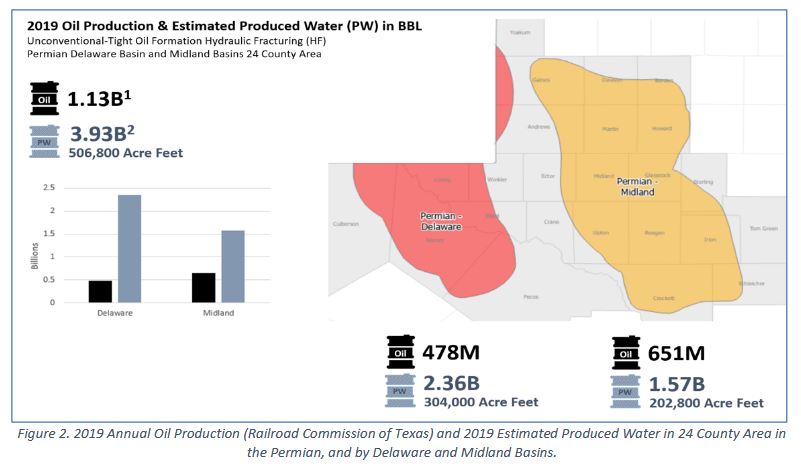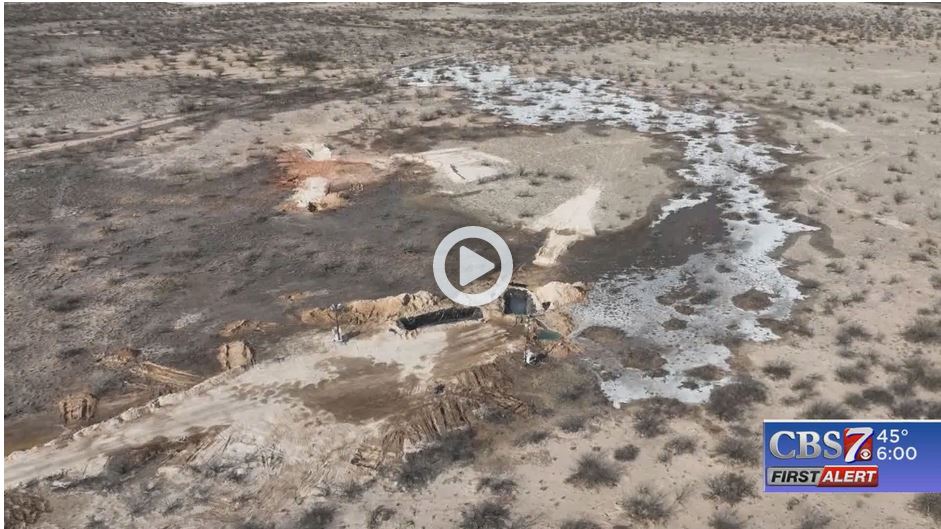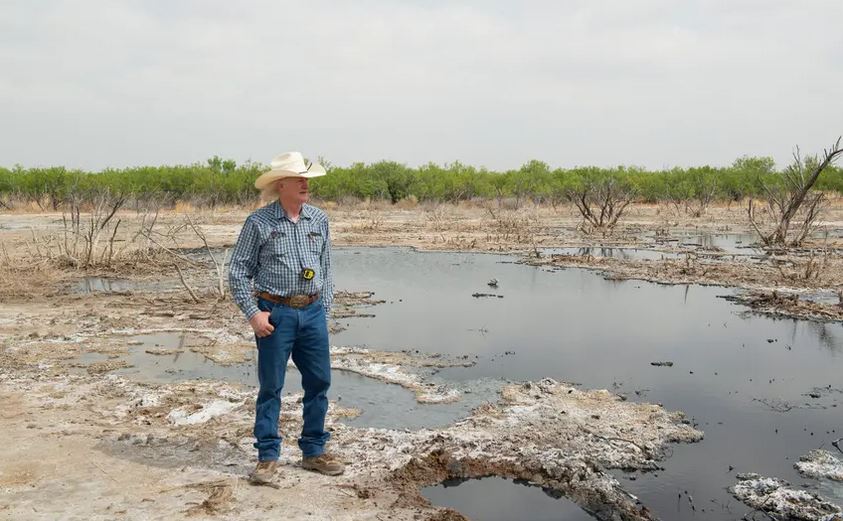The podcast The Disconnect has begun Season Three, about the role of gas producers and pipelines in the Big Freeze of 2022., This is the third of a series by Mose Buschele, energy and environmental reporter at KUT and NPR. The first two episodes are out, and you can listen here. Mose has done a great job making the complex Texas grid understandable and calling out those responsible for the 2022 blackout. The Texas grid is not out of the woods yet.
Articles Posted in Energy and the Environment
Geysers of Injected Wastewater in West Texas
Three scientists with the Department of Earth Sciences at Southern Methodist University have published the results of a study of blowouts of old wells in the Permian Basin caused by injection of produced water. The summary from the study:
Wastewater, a byproduct during oil extraction, is generally injected back into the ground. Permian Basin has witnessed several incidents of leakage of wastewater in the last 3 years. Recently in January 2022, huge amounts of wastewater were expelled at a high pressure from an old well. We used satellite data and wastewater injection data to understand the cause of these events. We found that the wastewater injection happening nearly several kilometers away is responsible for these leakages. We also discovered a highly pressurized wastewater lake below the surface in this region using geophysical modeling. Due to high pressures, the land in this region rose by 40 cm in just 2 years. Meanwhile, a part of this region sunk by 3 cm because of the leakage in January 2022. Our findings raise concerns about the potential for more leakages in the near future if action is not taken.
The study focused on the Central Basin Platform in the Permian Basin:
Disposal of Produced Water in the Permian Basin
In 2021 the Texas Legislature created the Texas Produced Water Consortium to study possible beneficial uses of fluid oil and gas wastes. The Consortium produced its report to the Legislature in 2022. I recently ran across a remarkable conclusion in that report: it estimates that in 2019 unconventional tight-oil formation wells in the Texas portion of the Permian Basin produced almost 4 billion barrels, or 506,800 acre-feet, of wastewater. (click on image to enlarge)
 506,800 acre-feet is a column of water covering an acre of land and 96 miles high. Or 11.6 square miles covered one foot deep in water. Lake Buchanan, the largest Texas lake, has a capacity of 992,000 acre-feet. New York City consumes 1,236,000 acre-feet of water per year.
506,800 acre-feet is a column of water covering an acre of land and 96 miles high. Or 11.6 square miles covered one foot deep in water. Lake Buchanan, the largest Texas lake, has a capacity of 992,000 acre-feet. New York City consumes 1,236,000 acre-feet of water per year.
It is no wonder that the underground injection of such a huge volume of water is causing problems. Much of that water is being injected into shallow oil-producing formations, in particular the depths of the Delaware Mountain Group, damaging producing wells and causing waste. The increased pressures in injection zones have caused abandoned wells to erupt in gushers of injected water. And water injection is inducing seismic events, otherwise known as earthquakes. The Railroad Commission has even ordered some injection wells to be shut down in response to those quakes.
Crane County salt water spill from overpressured zone used for water disposal
This link shows a report from CBS Odessa affiliate about a huge leak of injected water. These events are occurring all over West Texas because the Railroad Commission grants permits to dispose of produced water into shallow formations. Thousands of old wellbores exist in West Texas, some never plugged, some plugged before regulation of wells, some plugged in violation of regulations. The over-pressurized formation breaks into the wellbore, or finds its way to the surface. Until the Commission addresses the problem by properly regulating produced water injection, these problems will only grow. (Click on image to enlarge)
Colors of Hydrogen
Maybe you’ve heard of “green hydrogen.” There’s been a lot of press lately about projects to produce hydrogen to use as an alternative fuel, and the Inflation Adjustment Act provides tax credits for production of “green hydrogen.” But did you know that there are other hydrogen “colors”? An excellent article from MartenLaw.com provides a summary of the methods and tax credits and regulations being developed for green hydrogen programs. Here is its description of colors of hydrogen:
Types of Hydrogen
Hydrogen can be created through a variety of techniques. To distinguish between the different processes, the industry has developed an informal color-based categorization system:
Does the Railroad Commission have to plug P-13 wells?
A good article in Texas Tribune about the growing problem of P-13 wells that are leaking and contaminating land and groundwater.
When an oil and gas operator drills a dry hole or decides to abandon a well, instead of plugging the well it can transfer the well to the surface owner to re-complete as a water well. The parties file a Form P-13 with the Railroad Commission to accomplish that change in ownership. The Commission and the operator contend that the surface owner then becomes responsible for plugging the well. But apparently the law is not so clear on the issue. The Middle Pecos Groundwater District contends that some 40 P-13 wells in its area are the responsibility of the Railroad Commission to plug as orphan wells. The problem is exacerbated by operators using a shallow formation to dispose of produced water; the formation is pressured up and unplugged P-13 wells become a conduit for flowing polluted salt water to come up the wellbore.
The Disconnect Part 2
Last year KUT produced a podcast, “The Disconnect,” chronicling the February 2021 Texas freeze and blackout. KUT has now produced Part 2: “The Disconnect: Power, Politics and the Texas Blackout,” explaining what has happened since–what has been fixed, the cost in electric bills, and the aftermath–hosted by KUT reporter Mose Buchele. An excellent look at what the legislature, regulators, gas producers and generators have and have not done to prevent future system failures.
Yesterday the Texas Railroad Commission approved new regulations requiring well, gas plant and pipeline operators to winterize their facilities. Critics are skeptical they will do the job.
Energy Switch, a New Documentary Series with Scott Tinker on Energy and Climate
Dr. Scott Tinker will host a 12-episode TV series on energy and climate, on Austin’s PBS station, KLRU, beginning September 4 at 6 pm and streaming on PBS.org. More information can be found here.
From the press release:
Energy and climate are intertwined, two of the most important topics in the world today. Yet very little is known about them. This show aims to change that. ENERGY SWITCH brings together two renowned experts from government, NGOs, academia and industry, with differing perspectives on important energy and climate topics, such as: Could solar and wind power our future? Or could hydrogen be the dominant energy source? Should we have more or less nuclear power? How should we respond to climate change? What policies most effectively reduce emissions? How could we pay for them?
Winter Storm Uri: The causes of the massive Texas power failure detailed in UT report
We’ve seen much posturing and finger-pointing from politicians on who is to blame for power failures during Winter Storm Uri last February. UT’s Austin Energy Institute has issued a report: The timeline and Events of the February 2021 Texas Electric Grid Blackouts, laying out the facts on what happened. The POWER Committee of the Austin Energy Institute, chaired by Dr. Carey King, issued this report. Dr. King does research related to how energy systems interact within the economy and environment, and how policy and social systems can made decisions and trade-offs among competing factors. The report clarifies how much the reduction in natural gas supply contributed to the disaster.
Summary from the report:
Factors contributing to the electricity blackouts of February 15-18, 2021, include the following: Continue reading →
Fallout from February 2021 Freeze Continues
With the recent cold snap, we’re all remembering what we were doing last February when the lights went out.
Repercussions continue. As reported by Michell Ferman at Texas Tribune, Vistra corporation is in a dispute with Energy Transfer over its bill to Vistra for $21.6 million, for gas sold to Vistra during the freeze. Energy Transfer has threatened to cut off gas supplies to Vistra if it doesn’t pay, and Vistra has asked the Texas Railroad Commission to prevent that. Ferman writes:
During last year’s winter storm — which caused the near-total collapse of the state’s power grid, left millions without power for days and caused hundreds of deaths — Vistra spent approximately $1.5 billion for natural gas, ‘twice its planned natural gas cost to fuel its entire Texas fleet for a full year,’ the filing said. Vistra paid Energy Transfer more than $600 million during the storm, ‘which is more than 96% of all amounts invoiced by [Energy Transfer].’
 Oil and Gas Lawyer Blog
Oil and Gas Lawyer Blog



